Agricultural Biomass-Based Power Generation Potential in Sri Lanka: A Techno-Economic Analysis
Abstract
1. Introduction
Biomass Generation and Energy Conversion
2. Methodology, Empirical Modeling, and Data
2.1. Chemical and Physical Analysis of Rice Straw and Rice Husk
2.2. Determination of Energy Potential
2.3. Economic Analysis
Grate-Fired Combustion Followed by a Steam Turbine Cycle (GFC/ST)
3. Results
3.1. Chemical and Physical Properties of Rice Straw and Rice Husk
3.1.1. Thermogravimetric Analysis
3.1.2. Energy Dispersive X-ray Analysis (EDX)
3.2. Energy Potentials
3.3. Economic Analysis
4. Discussion
5. Conclusions
Author Contributions
Funding
Data Availability Statement
Acknowledgments
Conflicts of Interest
Appendix A
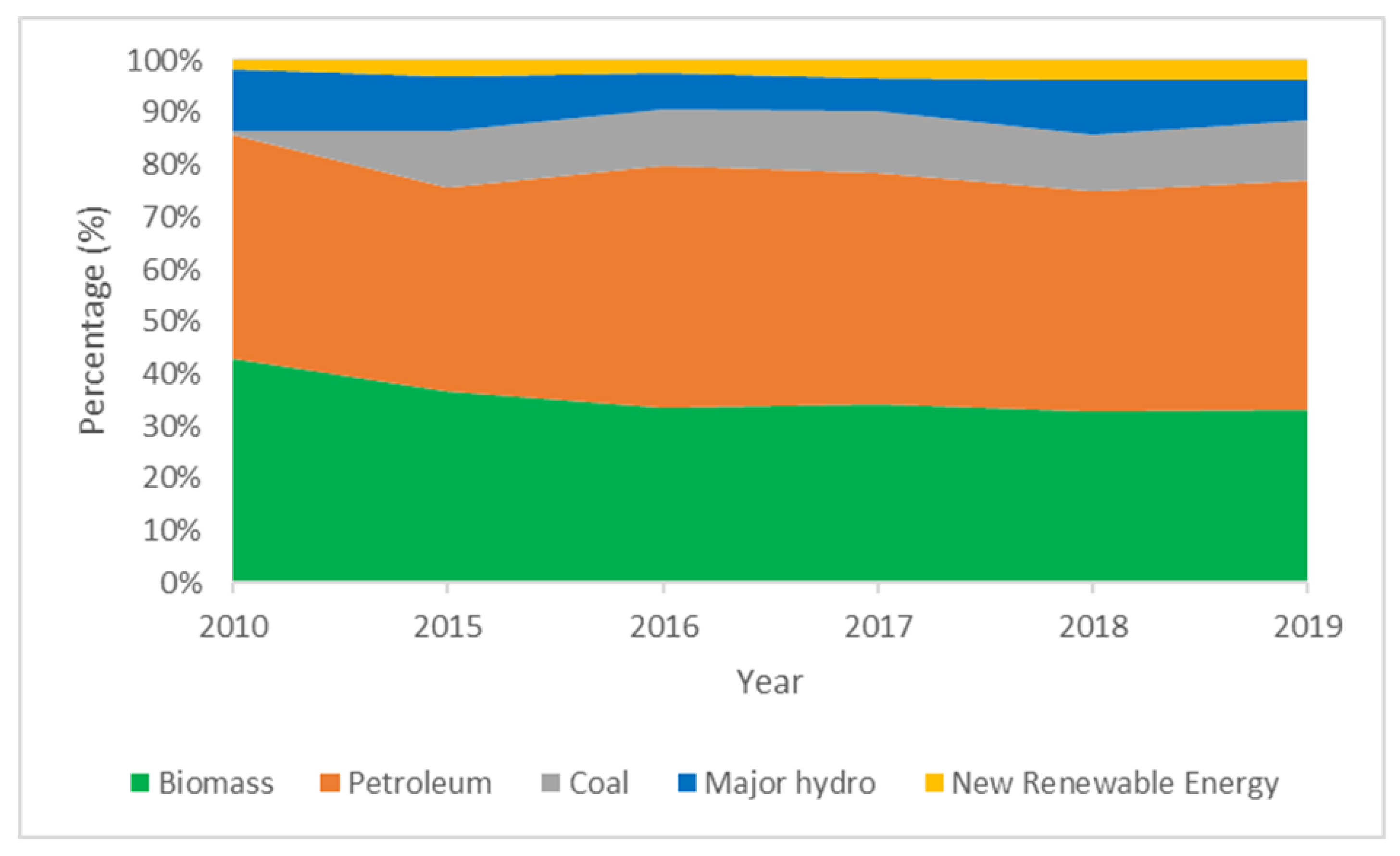

References
- Dutt, A. Accelerating Renewable Energy Investments in Sri Lanka; Centre for Energy Finance, Council on Energy, Environment and Water (CEEW): New Delhi, India, 2020. [Google Scholar]
- Ritchie, H.; Roser, M.; Rosado, P. Sri Lanka: Energy Country Profile. Available online: https://ourworldindata.org/energy/country/sri-lanka#citation (accessed on 15 November 2022).
- Asian Development Bank. Sri Lanka Energy Sector Assessment, Strategy and Road Map; Asian Development Bank: Manila, Philippines, 2019. [Google Scholar]
- Share of Renewables in Electricity Production. Available online: https://yearbook.enerdata.net/renewables/renewable-in-electricity-production-share.html (accessed on 5 November 2022).
- Adittiya, S.W. SL Needs 10,000 MW of Renewable Energy to Meet 2030 Target: Official. Daily FT 2020. Available online: https://www.ft.lk/front-page/SL-needs-10-000-MW-of-renewable-energy-to-meet-2030-target-official/44-695612 (accessed on 5 November 2022).
- Singh, M.; Keswani, S.; Chitkara, P.; Joseph, R.; Singha, H.; Sen, S.; Mahindru, G.; Rao, V.; Sumanasekaran, P.; Shazaad, N.; et al. 100% Percent Electricity Generation through Renewable Energy by 2050: Assessment of Sri Lanka’s Power Sector; Asian Development Bank: Manila, Philippines, 2021. [Google Scholar]
- Rodrigo, A.S.; Perera, S. Potential and Viability of Rice Husk Based Power Generation in Sri Lanka. Eng. J. Inst. Eng. Sri Lanka 2013, 46, 9. [Google Scholar] [CrossRef]
- Qian, X.; Xue, J.; Yang, Y.; Lee, S.W. Thermal Properties and Combustion-Related Problems Prediction of Agricultural Crop Residues. Energies 2021, 14, 4619. [Google Scholar] [CrossRef]
- Shinde, R.; Shahi, D.K.; Mahapatra, P.; Singh, C.S.; Naik, S.K.; Thombare, N.; Singh, A.K. Management of Crop Residues with Special Reference to the On-Farm Utilization Methods: A Review. Ind. Crops Prod. 2022, 181, 114772. [Google Scholar] [CrossRef]
- Gómez, A.; Zubizarreta, J.; Rodrigues, M.; Dopazo, C.; Fueyo, N. An Estimation of the Energy Potential of Agro-Industrial Residues in Spain. Resour. Conserv. Recycl. 2010, 54, 972–984. [Google Scholar] [CrossRef]
- Caputo, A.C.; Scacchia, F.; Pelagagge, P.M. Disposal of By-Products in Olive Oil Industry: Waste-to-Energy Solutions. Appl. Therm. Eng. 2003, 23, 197–214. [Google Scholar] [CrossRef]
- di Fraia, S.; Fabozzi, S.; Macaluso, A.; Vanoli, L. Energy Potential of Residual Biomass from Agro-Industry in a Mediterranean Region of Southern Italy (Campania). J. Clean Prod. 2020, 277, 124085. [Google Scholar] [CrossRef]
- McKendry, P. Energy Production from Biomass (Part 1): Overview of Biomass. Bioresour. Technol. 2002, 83, 37–46. [Google Scholar] [CrossRef]
- McKendry, P. Energy Production from Biomass (Part 2): Conversion Technologies. Bioresour. Technol. 2002, 83, 47–54. [Google Scholar] [CrossRef]
- Muigai, H.H.; Bordoloi, U.; Hussain, R.; Ravi, K.; Moholkar, V.S.; Kalita, P. A Comparative Study on Synthesis and Characterization of Biochars Derived from Lignocellulosic Biomass for Their Candidacy in Agronomy and Energy Applications. Int. J. Energy Res. 2021, 45, 4765–4781. [Google Scholar] [CrossRef]
- Zhou, Q.; Le, Q.V.; Yang, H.; Gu, H.; Yang, Y.; Sonne, C.; Tabatabaei, M.; Lam, S.S.; Li, C.; Chen, X.; et al. Sustainable Conversion of Agricultural Biomass into Renewable Energy Products: A Discussion. Bioresources 2022, 17, 3489–3508. [Google Scholar] [CrossRef]
- Kretschmer, B.; Allen, B.; Kieve, D.; Smith, C. Shifting Away from Conventional Biofuels: Sustainable Alternatives for the Use of Biomass in the UK Transport Sector; Institute for European Environmental Policy (IEEP): London, UK, 2013. [Google Scholar]
- Copa Rey, J.R.; Tamayo Pacheco, J.J.; António da Cruz Tarelho, L.; Silva, V.; Cardoso, J.S.; Silveira, J.L.; Tuna, C.E. Evaluation of Cogeneration Alternative Systems Integrating Biomass Gasification Applied to a Brazilian Sugar Industry. Renew. Energy 2021, 178, 318–333. [Google Scholar] [CrossRef]
- Mohapatra, S.S.; Rath, M.K.; Singh, R.K.; Murugan, S. Performance and Emission Analysis of Co-Pyrolytic Oil Obtained from Sugarcane Bagasse and Polystyrene in a CI Engine. Fuel 2021, 298, 120813. [Google Scholar] [CrossRef]
- Ren, J.; Yu, P.; Xu, X. Straw Utilization in China—Status and Recommendations. Sustainability 2019, 11, 1762. [Google Scholar] [CrossRef]
- Fleig, O.P.; Raymundo, L.M.; Trierweiler, L.F.; Trierweiler, J.O. Study of Rice Husk Continuous Torrefaction as a Pretreatment for Fast Pyrolysis. J. Anal. Appl. Pyrolysis 2021, 154, 104994. [Google Scholar] [CrossRef]
- Morrissey, K.G.; Thoma, G.; López, D.E. Life Cycle Impact Assessment of Biofuels Derived from Sweet Sorghum in the U.S. Biotechnol. Biofuels 2021, 14, 166. [Google Scholar] [CrossRef]
- Elnajjar, E.; Syam, M.M.; Al-Omari, S. Experimental Investigations of Bio-Syngas Production Using Microwave Pyrolysis of UAE’S Palm Date Seed Pits. Fuel 2021, 303, 121348. [Google Scholar] [CrossRef]
- Migo-Sumagang, M.V.P.; van Hung, N.; Detras, M.C.M.; Alfafara, C.G.; Borines, M.G.; Capunitan, J.A.; Gummert, M. Optimization of a Downdraft Furnace for Rice Straw-Based Heat Generation. Renew. Energy 2020, 148, 953–963. [Google Scholar] [CrossRef]
- Vaskalis, I.; Skoulou, V.; Stavropoulos, G.; Zabaniotou, A. Towards Circular Economy Solutions for The Management of Rice Processing Residues to Bioenergy via Gasification. Sustainability 2019, 11, 6433. [Google Scholar] [CrossRef]
- Magnago, R.F.; Costa, S.C.; de Assunção Ezirio, M.J.; de Godoy Saciloto, V.; Cremona Parma, G.O.; Gasparotto, E.S.; Gonçalves, A.C.; Tutida, A.Y.; Barcelos, R.L. Briquettes of Citrus Peel and Rice Husk. J. Clean Prod. 2020, 276, 123820. [Google Scholar] [CrossRef]
- Payá, J.; Monzó, J.; Borrachero, M.V.; Peris-Mora, E.; Ordóñez, L.M. Studies on Crystalline Rice Husk Ashes and the Activation of Their Pozzolanic Properties. In Waste Management Series; Elsevier: Amsterdam, The Netherlands, 2000; pp. 493–503. [Google Scholar]
- Hossain, S.S.; Mathur, L.; Roy, P.K. Rice Husk/Rice Husk Ash as an Alternative Source of Silica in Ceramics: A Review. J. Asian Ceram. Soc. 2018, 6, 299–313. [Google Scholar] [CrossRef]
- Oliveira, M.O.; Neto, J.M.; Inocencio, M.C.; Ando Junior, O.H.; Bretas, A.S.; Perrone, O.E. Viability Study for Use of Rice Husk in Electricity Generation by Biomass. Renew. Energy Power Qual. J. 2012, 1, 1655–1658. [Google Scholar] [CrossRef]
- Stanmore, B.R. Generation of Energy from Sugarcane Bagasse by Thermal Treatment. Waste Biomass Valorization 2010, 1, 77–89. [Google Scholar] [CrossRef]
- Kirubakaran, V.; Sivaramakrishnan, V.; Nalini, R.; Sekar, T.; Premalatha, M.; Subramanian, P. A Review on Gasification of Biomass. Renew. Sustain. Energy Rev. 2009, 13, 179–186. [Google Scholar] [CrossRef]
- Zhang, L.; Xu, C.; Champagne, P. Overview of Recent Advances in Thermo-Chemical Conversion of Biomass. Energy Convers. Manag. 2010, 51, 969–982. [Google Scholar] [CrossRef]
- Bhavanam, A.; Sastry, R.C. Biomass Gasification Processes in Downdraft Fixed Bed Reactors: A Review. Int. J. Chem. Eng. Appl. 2011, 2, 425. [Google Scholar]
- Celma, A.; Rojas, S.; Lopezrodriguez, F. Waste-to-Energy Possibilities for Industrial Olive and Grape by-Products in Extremadura. Biomass Bioenergy 2007, 31, 522–534. [Google Scholar] [CrossRef]
- Dornburg, V.; Faaij, A.P.C. Efficiency and Economy of Wood-Fired Biomass Energy Systems in Relation to Scale Regarding Heat and Power Generation Using Combustion and Gasification Technologies. Biomass Bioenergy 2001, 21, 91–108. [Google Scholar] [CrossRef]
- Faaij, A. Modern Biomass Conversion Technologies. Mitig. Adapt Strateg. Glob. Chang. 2006, 11, 343–375. [Google Scholar] [CrossRef]
- Mohiuddin, O.; Mohiuddin, A.; Obaidullah, M.; Ahmed, H.; Asumadu-Sarkodie, S. Electricity Production Potential and Social Benefits from Rice Husk, a Case Study in Pakistan. Cogent Eng. 2016, 3, 1177156. [Google Scholar] [CrossRef]
- Roberts, J.J.; Cassula, A.M.; Osvaldo Prado, P.; Dias, R.A.; Balestieri, J.A.P. Assessment of Dry Residual Biomass Potential for Use as Alternative Energy Source in the Party of General Pueyrredón, Argentina. Renew. Sustain. Energy Rev. 2015, 41, 568–583. [Google Scholar] [CrossRef]
- Kumar, A.; Nayak, A.K.; Sharma, S.; Senapati, A.; Mitra, D.; Mohanty, B.; Prabhukarthikeyan, S.R.; Sabarinathan, K.G.; Mani, I.; Garhwal, R.S.; et al. Recycling of Rice Straw—A Sustainable Approach for Ensuring Environmental Quality and Economic Security: A Review. Pedosphere 2022, in press. [Google Scholar] [CrossRef]
- Qian, X.; Lee, S.; Soto, A.; Chen, G. Regression Model to Predict the Higher Heating Value of Poultry Waste from Proximate Analysis. Resources 2018, 7, 39. [Google Scholar] [CrossRef]
- Yin, C.-Y. Prediction of Higher Heating Values of Biomass from Proximate and Ultimate Analyses. Fuel 2011, 90, 1128–1132. [Google Scholar] [CrossRef]
- Nhuchhen, D.R.; Abdul Salam, P. Estimation of Higher Heating Value of Biomass from Proximate Analysis: A New Approach. Fuel 2012, 99, 55–63. [Google Scholar] [CrossRef]
- Ghugare, S.B.; Tiwary, S.; Elangovan, V.; Tambe, S.S. Prediction of Higher Heating Value of Solid Biomass Fuels Using Artificial Intelligence Formalisms. Bioenergy Res. 2014, 7, 681–692. [Google Scholar] [CrossRef]
- El-Kordy, M.N.; Badr, M.A.; Abed, K.A.; Ibrahim, S.M.A. Economical Evaluation of Electricity Generation Considering Externalities. Renew. Energy 2002, 25, 317–328. [Google Scholar] [CrossRef]
- Wickwire, S. Biomass Combined Heat and Power Catalog of Technologies; U.S. Environmental Protection Agency: Washington, DC, USA, 2007. [Google Scholar]
- Morató, T.; Vaezi, M.; Kumar, A. Techno-Economic Assessment of Biomass Combustion Technologies to Generate Electricity in South America: A Case Study for Bolivia. Renew. Sustain. Energy Rev. 2020, 134, 110154. [Google Scholar] [CrossRef]
- Jayatissa de Costa Non Conventional Renewable Energy Tariff Announcement Purchase of Electricity to the National Grid under Standardized Power Purchase Agreements (SPPA). Available online: https://web.pucsl.gov.lk/english/notices/non-conventional-renewable-energy-tariff-announcement-purchase-of-electricity-to-the-national-grid-under-standardized-power-purchase-agreements-sppa/ (accessed on 25 May 2022).
- Matsumura, Y.; Minowa, T.; Yamamoto, H. Amount, Availability, and Potential Use of Rice Straw (Agricultural Residue) Biomass as an Energy Resource in Japan. Biomass Bioenergy 2005, 29, 347–354. [Google Scholar] [CrossRef]
- Asadi Zeidabadi, Z.; Bakhtiari, S.; Abbaslou, H.; Ghanizadeh, A.R. Synthesis, Characterization and Evaluation of Biochar from Agricultural Waste Biomass for Use in Building Materials. Constr. Build Mater. 2018, 181, 301–308. [Google Scholar] [CrossRef]
- Weber, K.; Quicker, P. Properties of Biochar. Fuel 2018, 217, 240–261. [Google Scholar] [CrossRef]
- Xiao, B.; Sun, X.F.; Sun, R. Chemical, Structural, and Thermal Characterizations of Alkali-Soluble Lignins and Hemicelluloses, and Cellulose from Maize Stems, Rye Straw, and Rice Straw. Polym. Degrad. Stab. 2001, 74, 307–319. [Google Scholar] [CrossRef]
- Sun, Y.; Webley, P.A. Preparation of Activated Carbons from Corncob with Large Specific Surface Area by a Variety of Chemical Activators and Their Application in Gas Storage. Chem. Eng. J. 2010, 162, 883–892. [Google Scholar] [CrossRef]
- Satlewal, A.; Agrawal, R.; Bhagia, S.; Das, P.; Ragauskas, A.J. Rice Straw as a Feedstock for Biofuels: Availability, Recalcitrance, and Chemical Properties. Biofuels Bioprod. Biorefining 2018, 12, 83–107. [Google Scholar] [CrossRef]
- Vassilev, S.v.; Baxter, D.; Andersen, L.K.; Vassileva, C.G. An Overview of the Chemical Composition of Biomass. Fuel 2010, 89, 913–933. [Google Scholar] [CrossRef]
- Sannigrahi, P.; Ragauskas, A.J.; Tuskan, G.A. Poplar as a Feedstock for Biofuels: A Review of Compositional Characteristics. Biofuels Bioprod. Biorefining 2010, 4, 209–226. [Google Scholar] [CrossRef]
- Sri Lanka—River and Streams. Available online: https://data.humdata.org/dataset/sri-lanka-water-bodies-0-0 (accessed on 25 March 2022).
- Sellitto, M.A.; Kadel, N.; Borchardt, M.; Pereira, G.M.; Domingues, J. Rice husk and scrap tires co-processing and reverse logistics in cement manufacturing. Ambiente Soc. 2013, 16, 141–162. [Google Scholar] [CrossRef]
- Srivastava, V.C.; Mall, I.D.; Mishra, I.M. Adsorption Thermodynamics and Isosteric Heat of Adsorption of Toxic Metal Ions onto Bagasse Fly Ash (BFA) and Rice Husk Ash (RHA). Chem. Eng. J. 2007, 132, 267–278. [Google Scholar] [CrossRef]
- Abo-El-Enein, S.A.; Eissa, M.A.; Diafullah, A.A.; Rizk, M.A.; Mohamed, F.M. Removal of Some Heavy Metals Ions from Wastewater by Copolymer of Iron and Aluminum Impregnated with Active Silica Derived from Rice Husk Ash. J. Hazard Mater. 2009, 172, 574–579. [Google Scholar] [CrossRef]
- Ajmal, M.; Ali Khan Rao, R.; Anwar, S.; Ahmad, J.; Ahmad, R. Adsorption Studies on Rice Husk: Removal and Recovery of Cd(II) from Wastewater. Bioresour. Technol. 2003, 86, 147–149. [Google Scholar] [CrossRef]
- Rocha, C.G.; Zaia, D.A.M.; Alfaya, R.V.d.S.; Alfaya, A.A. da S. Use of Rice Straw as Biosorbent for Removal of Cu(II), Zn(II), Cd(II) and Hg(II) Ions in Industrial Effluents. J. Hazard Mater. 2009, 166, 383–388. [Google Scholar] [CrossRef]
- Amin, M.N.; Kaneco, S.; Kitagawa, T.; Begum, A.; Katsumata, H.; Suzuki, T.; Ohta, K. Removal of Arsenic in Aqueous Solutions by Adsorption onto Waste Rice Husk. Ind. Eng. Chem. Res. 2006, 45, 8105–8110. [Google Scholar] [CrossRef]
- Taimur Khan; Shahril Anwar Bin Ab Wahap; Malay Chaudhuri Adsorption of Arsenite from Water by Rice Husk Silica. Nat. Environ. Pollut. Technol. Int. Q. Sci. J. 2012, 11, 229–233.
- Wang, L.-H.; Lin, C.-I. Adsorption of Chromium (III) Ion from Aqueous Solution Using Rice Hull Ash. J. Chin. Inst. Chem. Eng. 2008, 39, 367–373. [Google Scholar] [CrossRef]
- Nakbanpote, W.; Thiravetyan, P.; Kalambaheti, C. Comparison of Gold Adsorption by Chlorella Vulgaris, Rice Husk and Activated Carbon. Miner. Eng. 2002, 15, 549–552. [Google Scholar] [CrossRef]
- Han, R.; Ding, D.; Xu, Y.; Zou, W.; Wang, Y.; Li, Y.; Zou, L. Use of Rice Husk for the Adsorption of Congo Red from Aqueous Solution in Column Mode. Bioresour. Technol. 2008, 99, 2938–2946. [Google Scholar] [CrossRef]
- Soltani, N.; Bahrami, A.; Pech-Canul, M.I.; González, L.A. Review on the Physicochemical Treatments of Rice Husk for Production of Advanced Materials. Chem. Eng. J. 2015, 264, 899–935. [Google Scholar] [CrossRef]
- Bondioli, F.; Andreola, F.; Barbieri, L.; Manfredini, T.; Ferrari, A.M. Effect of Rice Husk Ash (RHA) in the Synthesis of (Pr,Zr)SiO4 Ceramic Pigment. J. Eur. Ceram. Soc. 2007, 27, 3483–3488. [Google Scholar] [CrossRef]
- Andreola, F.; Barbieri, L.; Bondioli, F. Agricultural Waste in the Synthesis of Coral Ceramic Pigment. Dye. Pigment. 2012, 94, 207–211. [Google Scholar] [CrossRef]
- Nair, D.G.; Fraaij, A.; Klaassen, A.A.K.; Kentgens, A.P.M. A Structural Investigation Relating to the Pozzolanic Activity of Rice Husk Ashes. Cem. Concr. Res. 2008, 38, 861–869. [Google Scholar] [CrossRef]
- Papadakis, V.G.; Tsimas, S. Supplementary Cementing Materials in Concrete. Cem. Concr. Res. 2002, 32, 1525–1532. [Google Scholar] [CrossRef]
- Chandrasekhar, S.; Pramada, P.N.; Majeed, J. Effect of Calcination Temperature and Heating Rate on the Optical Properties and Reactivity of Rice Husk Ash. J. Mater. Sci. 2006, 41, 7926–7933. [Google Scholar] [CrossRef]
- Saraswathy, V.; Song, H.-W. Corrosion Performance of Rice Husk Ash Blended Concrete. Constr. Build Mater. 2007, 21, 1779–1784. [Google Scholar] [CrossRef]
- Gonçalves, M.R.F.; Bergmann, C.P. Thermal Insulators Made with Rice Husk Ashes: Production and Correlation between Properties and Microstructure. Constr. Build Mater. 2007, 21, 2059–2065. [Google Scholar] [CrossRef]
- Ugheoke, B.I.; Onche, E.O.; Namessan, O.N.; Asikpo, G.A. Property Optimization of Kaolin–Rice Husk Insulating Fire–Bricks. Leonardo Electron. J. Pract. Technol. 2006, 9, 167–178. [Google Scholar]
- Haxo, H.E.; Mehta, P.K. Ground Rice-Hull Ash as a Filler for Rubber. Rubber Chem. Technol. 1975, 48, 271–288. [Google Scholar] [CrossRef]
- Sae-Oui, P.; Rakdee, C.; Thanmathorn, P. Use of Rice Husk Ash as Filler in Natural Rubber Vulcanizates: In Comparison with Other Commercial Fillers. J. Appl. Polym. Sci. 2002, 83, 2485–2493. [Google Scholar] [CrossRef]
- Fuad, M.Y.A.; Ismail, Z.; Ishak, Z.A.M.; Omar, A.K.M. Application of Rice Husk Ash as Fillers in Polypropylene: Effect of Titanate, Zirconate and Silane Coupling Agents. Eur. Polym. J. 1995, 31, 885–893. [Google Scholar] [CrossRef]
- Siriwardena, S.; Ismail, H.; Ishiaku, U.S. White Rice Husk Ash Filled Ethylene-Propylene-Diene Terpolymer/Polypropylene Blends: Effect Of Dynamic Vulcanization And Filler Loading. Polym Plast Technol. Eng. 2001, 40, 519–538. [Google Scholar] [CrossRef]
- Siriwardena, S.; Ismail, H.; Ishiaku, U.S.; Perera, M.C.S. Mechanical and Morphological Properties of White Rice Husk Ash Filled Polypropylene/Ethylene-Propylene-Diene Terpolymer Thermoplastic Elastomer Composites. J. Appl. Polym. Sci. 2002, 85, 438–453. [Google Scholar] [CrossRef]
- Siriwardena, S.; Ismail, H.; Ishiaku, U.S. Water Absorption Behavior and Its Effect on Tensile Properties of Ethylene–Propylene–Diene–Terpolymer/Polypropylene/Filler Ternary Composites: A Preliminary Study. Polym. Plast. Technol. Eng. 2002, 41, 419–433. [Google Scholar] [CrossRef]
- John, M.J.; Francis, B.; Varughese, K.T.; Thomas, S. Effect of Chemical Modification on Properties of Hybrid Fiber Biocomposites. Compos. Part A Appl. Sci. Manuf. 2008, 39, 352–363. [Google Scholar] [CrossRef]
- Kalia, S.; Kaith, B.S.; Kaur, I. Pretreatments of Natural Fibers and Their Application as Reinforcing Material in Polymer Composites-A Review. Polym. Eng. Sci. 2009, 49, 1253–1272. [Google Scholar] [CrossRef]
- Cristaldi, G.; Latteri, A.; Recca, G.; Cicala, G. Composites Based on Natural Fibre Fabrics. In Woven Fabric Engineering; Dubrovski, P.D., Ed.; InTech: Rijeka, Croatia, 2010. [Google Scholar]
- Chaudhary, D.S.; Jollands, M.C.; Cser, F. Understanding Rice Hull Ash as Fillers in Polymers: A Review. Silicon Chem. 2002, 1, 281–289. [Google Scholar] [CrossRef]
- Adam, F. The Synthesis and Characterization of Cobalt-Rice Husk Silica Nanoparticles. Open Colloid Sci. J. 2011, 4, 12–18. [Google Scholar] [CrossRef]
- Ismail, H.; Mega, L.; Khalil, H.A. Effect of a Silane Coupling Agent on the Properties of White Rice Husk Ash-Polypropylene/Natural Rubber Composites. Polym. Int. 2001, 50, 606–611. [Google Scholar] [CrossRef]
- Omatola, K.M.; Onojah, A.D. Elemental Analysis of Rice Husk Ash Using X-Ray Fluorescence Technique. Int. J. Phys. Sci. 2009, 4, 189–193. [Google Scholar]
- Bose, S.; Acharya, H.N.; Banerjee, H.D. Electrocal, Thermal, Thermoelectric and Related Properties of Magnesium Silicide Semiconductor Prepared from Rice Husk. J. Mater. Sci. 1993, 28, 5461–5468. [Google Scholar] [CrossRef]
- Sellitto, M.A.; Kadel, N., Jr.; Borchardt, M.; Pereira, G.M.; Domingues, J. Coprocessamento de Cascas de Arroz e Pneus Inservíveis e Logística Reversa Na Fabricação de Cimento. Ambiente Soc. 2013, 16, 141–162. [Google Scholar] [CrossRef]
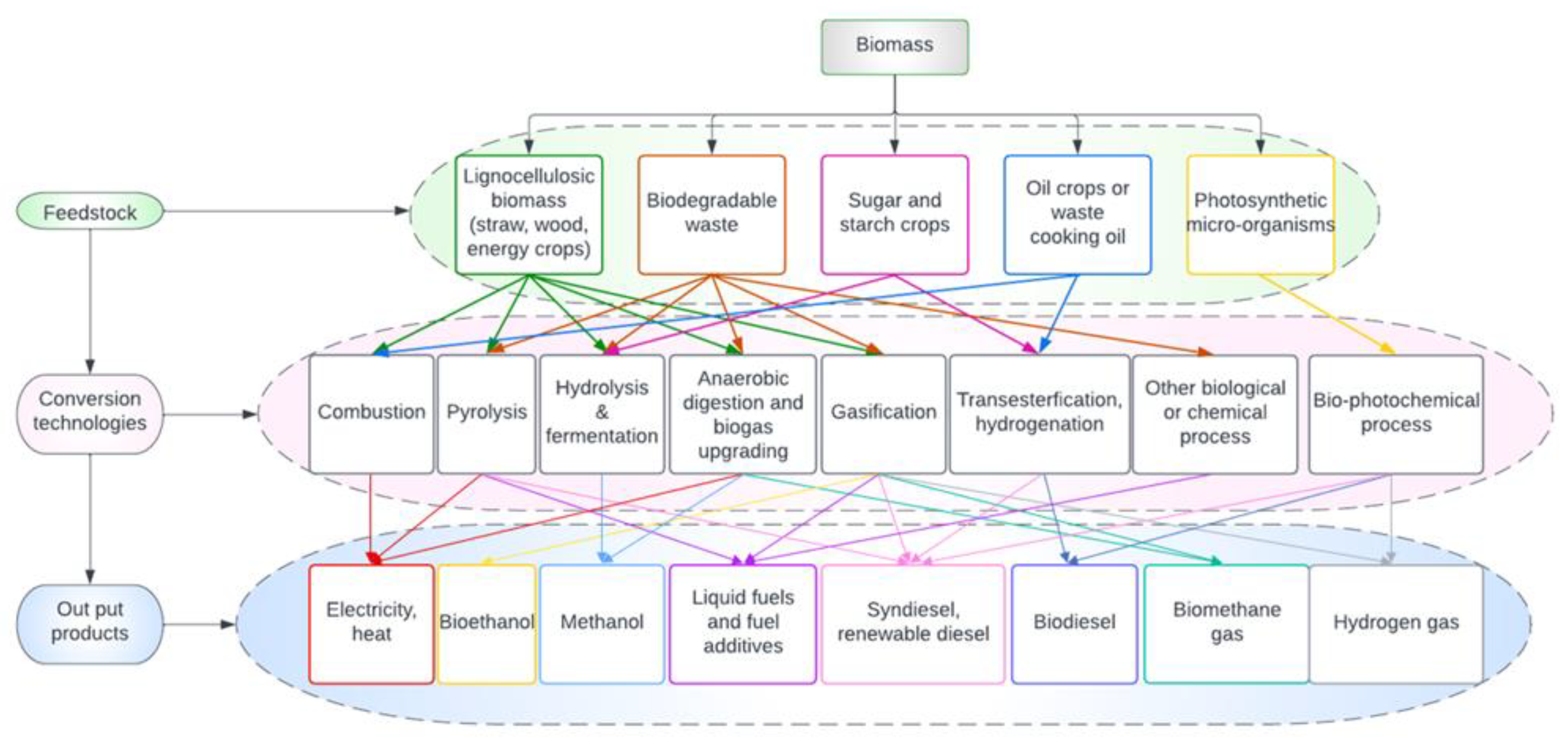

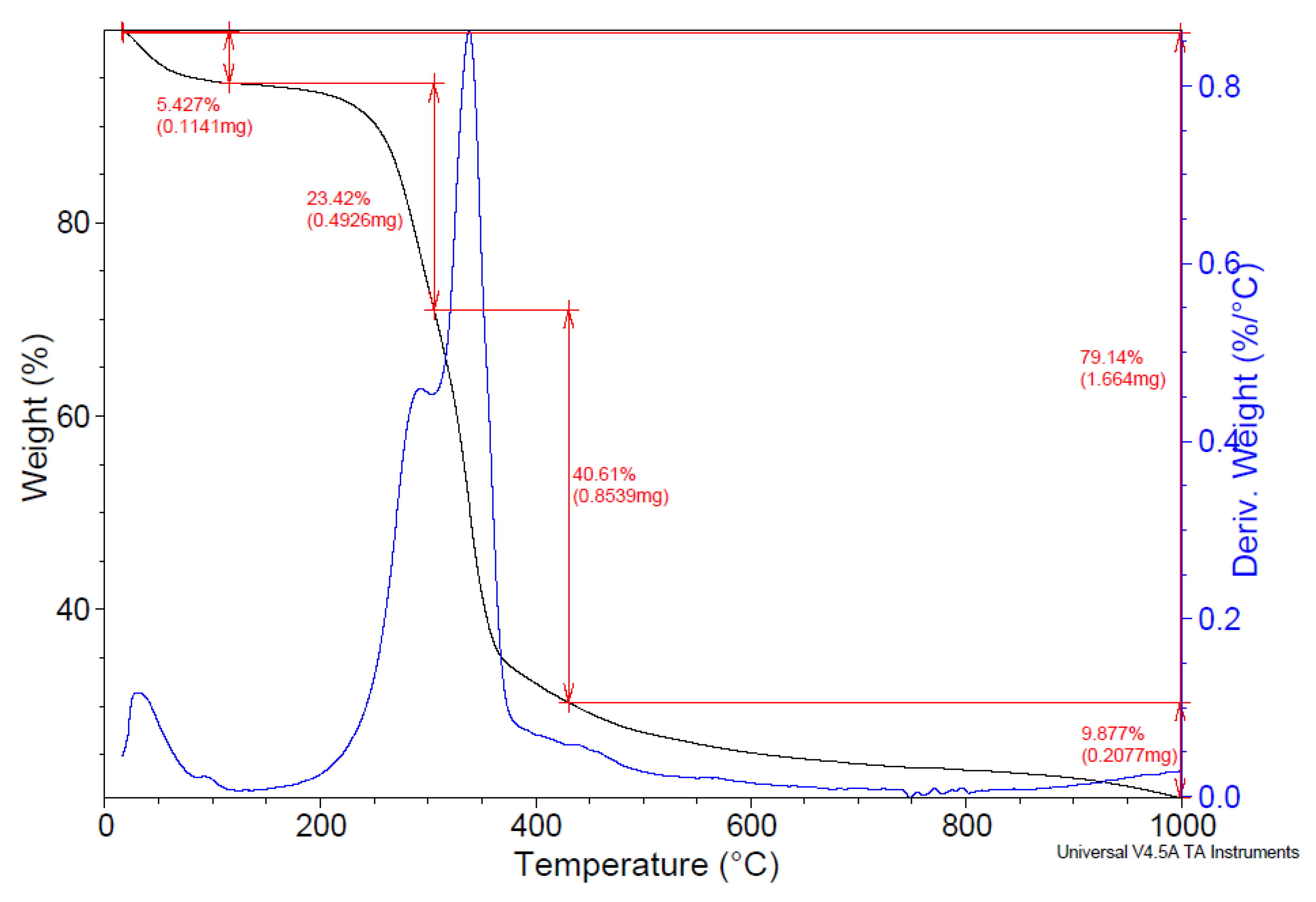
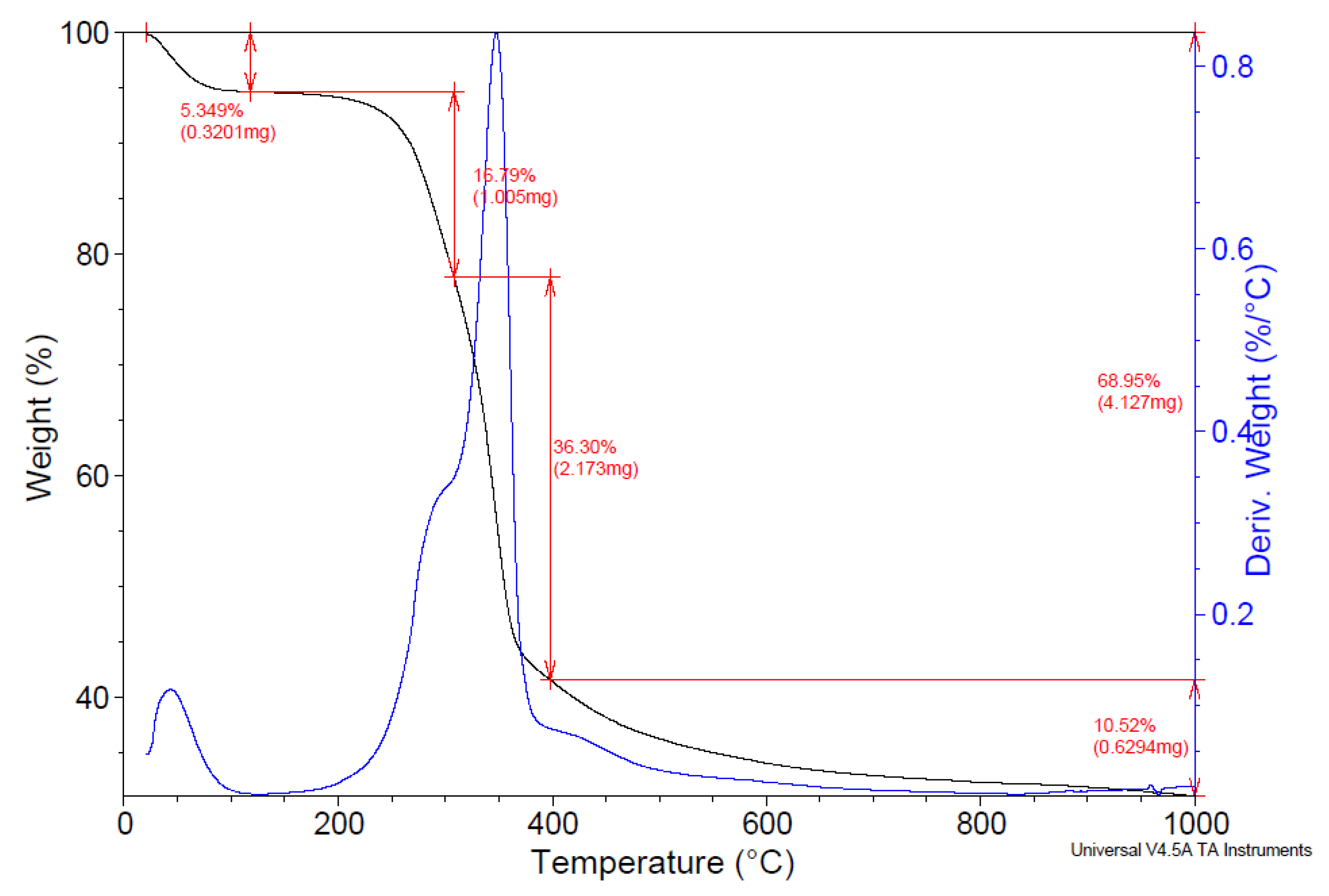

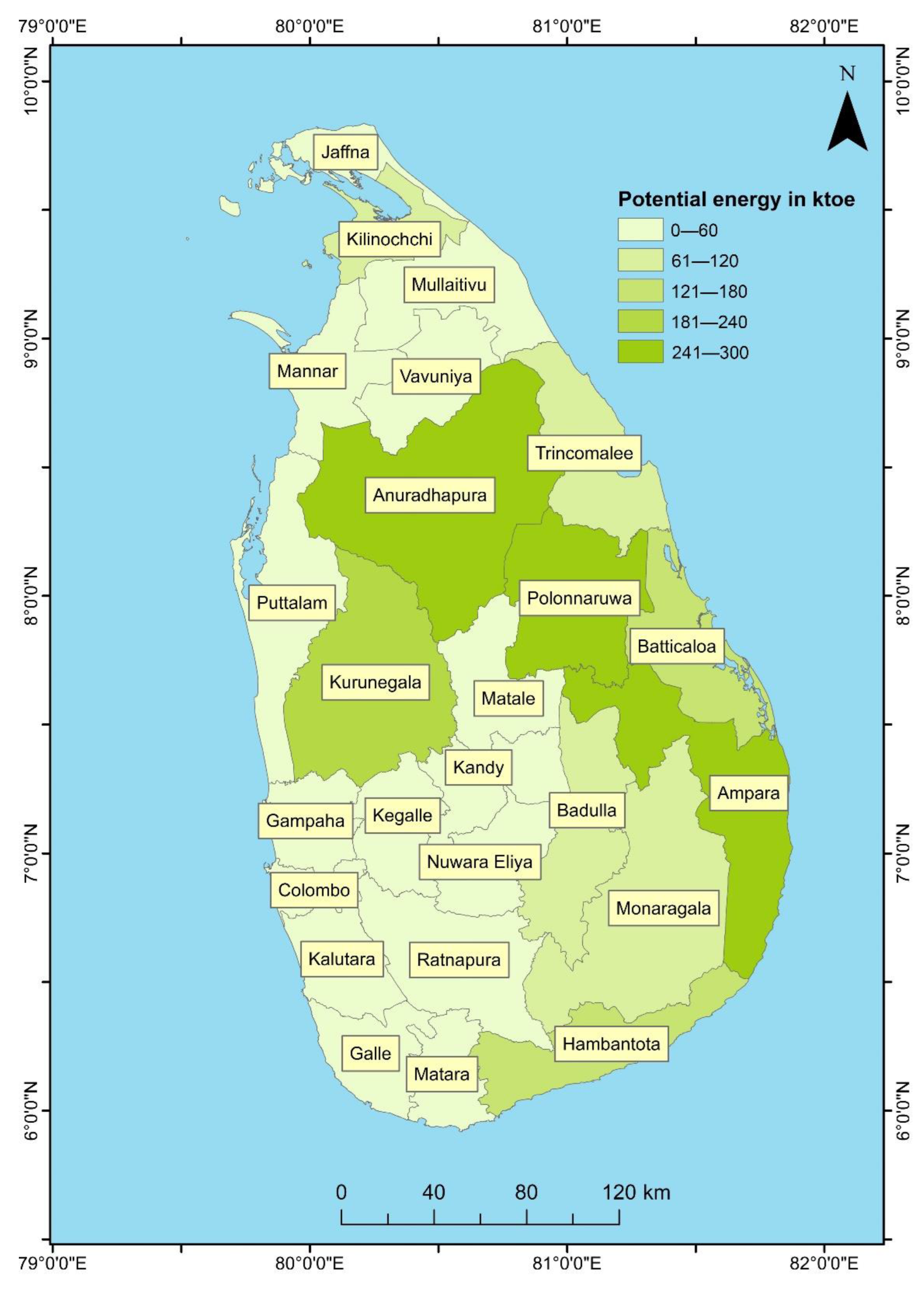
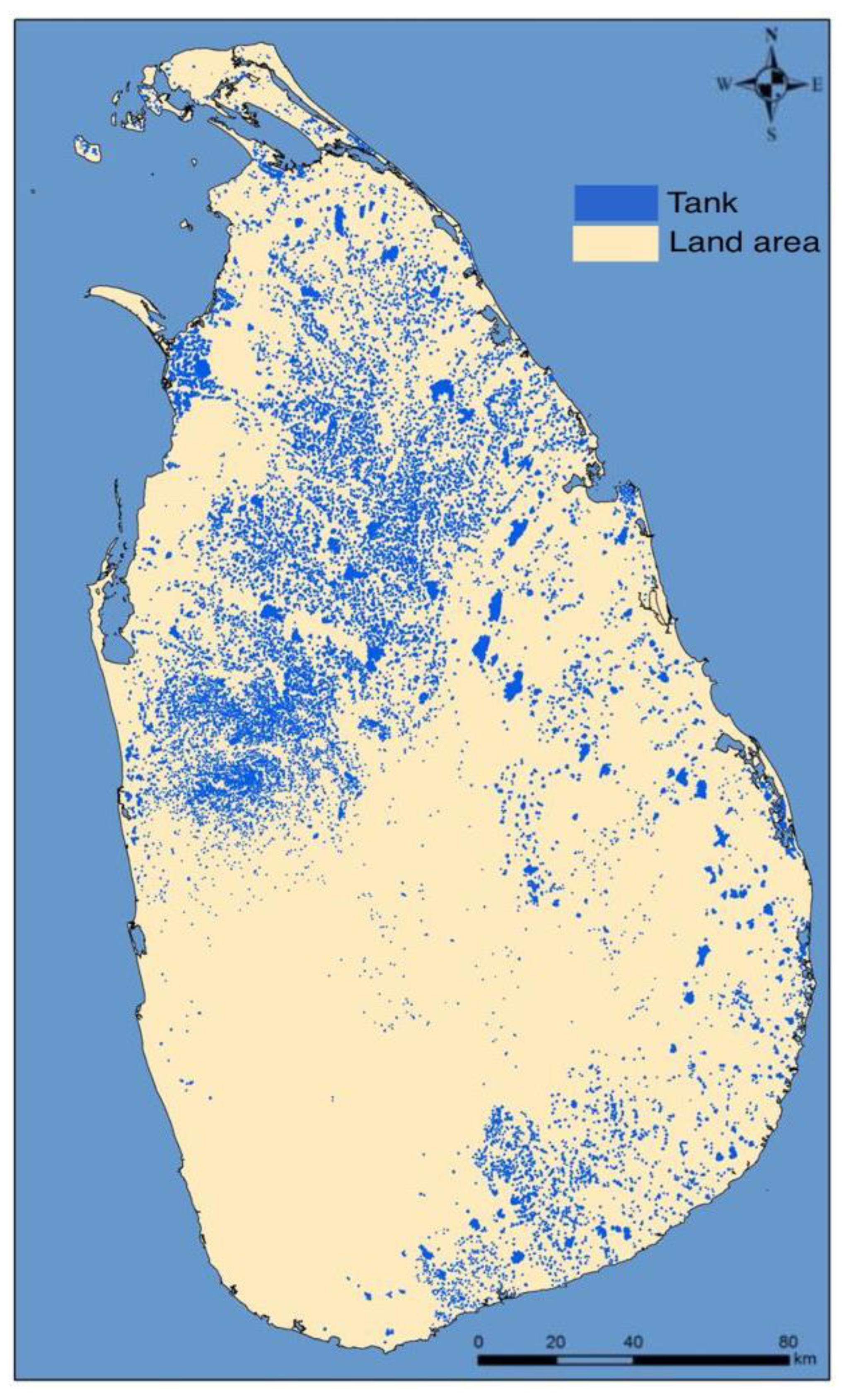


| Parameter | Value or Function |
|---|---|
| Lifetime of the plant (N) | 20 years |
| Discount Rate (i) | 15% |
| Investment Cost (IC, million $) | 4.89⋅(Capacity)0.85 * |
| Income of the Power Plant (R) | Wn h Tf |
| Flat tariff (Tf) | 17.71 LKR/kWh |
| Operating Costs (OC) | |
| Operation and Management cost (O&M) | 5% (LKR/year) |
| Cost of RS and RH (CRS,RH) | 2 × 10−19 (Capacity)3–6 × 10−13 (Capacity)2 + 2 × 10−6 (Capacity) + 12.767 * |
| Elements | Average Values (% wt) | |
|---|---|---|
| Rice Straw | Rice Husk | |
| C | 41.589 | 37.576 |
| O | 52.630 | 53.041 |
| Si | 3.814 | 9.284 |
| Ca | 0.966 | 0.066 |
| Mg | 0.353 | 0.009 |
| P | 0.235 | - |
| K | 0.209 | 0.021 |
| S | 0.144 | - |
| Cl | 0.031 | - |
| Mn | 0.026 | - |
| Properties | Average Values | |
|---|---|---|
| Rice Straw | Rice Husk | |
| Higher Heating Value (HHV) (MJ/kg) | 15.5 | 13.18 |
| Lower Heating Value (LHV) (MJ/kg) | 14.43 | 12.01 |
| Fixed Carbon (%wt) | 14.6 | 24.62 |
| Volatile Matter (%wt) | 60.28 | 46.13 |
| Ash (%wt) | 16.83 | 19.77 |
| Moisture (% wt) | 8.47 | 9.01 |
| District | Power (MW) | Generation (TWh) | NPV m (LKR) | PI |
|---|---|---|---|---|
| Anuradhapura | 176.41 | 1.23 | 201,353.7 | 4.86 |
| Ampara | 167.83 | 1.17 | 191,770.2 | 4.63 |
| Polonnaruwa | 163.48 | 1.14 | 186,915.5 | 4.62 |
| Kurunegala | 133.02 | 0.93 | 152,825.5 | 3.74 |
| Hambantota | 88.74 | 0.62 | 102,979.5 | 2.58 |
| Batticcaloa | 69.84 | 0.49 | 81,573.2 | 2.07 |
| Trincomalee | 57.82 | 0.40 | 67,899.8 | 1.73 |
| Monaragala | 53.86 | 0.38 | 63,383.8 | 1.63 |
| Killinochchi | 33.09 | 0.23 | 39,558.5 | 1.04 |
| Badulla | 32.98 | 0.23 | 39,425.9 | 1.04 |
Publisher’s Note: MDPI stays neutral with regard to jurisdictional claims in published maps and institutional affiliations. |
© 2022 by the authors. Licensee MDPI, Basel, Switzerland. This article is an open access article distributed under the terms and conditions of the Creative Commons Attribution (CC BY) license (https://creativecommons.org/licenses/by/4.0/).
Share and Cite
Illankoon, W.A.M.A.N.; Milanese, C.; Girella, A.; Rathnasiri, P.G.; Sudesh, K.H.M.; Llamas, M.M.; Collivignarelli, M.C.; Sorlini, S. Agricultural Biomass-Based Power Generation Potential in Sri Lanka: A Techno-Economic Analysis. Energies 2022, 15, 8984. https://doi.org/10.3390/en15238984
Illankoon WAMAN, Milanese C, Girella A, Rathnasiri PG, Sudesh KHM, Llamas MM, Collivignarelli MC, Sorlini S. Agricultural Biomass-Based Power Generation Potential in Sri Lanka: A Techno-Economic Analysis. Energies. 2022; 15(23):8984. https://doi.org/10.3390/en15238984
Chicago/Turabian StyleIllankoon, W. A. M. A. N., Chiara Milanese, Alessandro Girella, Puhulwella G. Rathnasiri, K. H. M. Sudesh, Maria Medina Llamas, Maria Cristina Collivignarelli, and Sabrina Sorlini. 2022. "Agricultural Biomass-Based Power Generation Potential in Sri Lanka: A Techno-Economic Analysis" Energies 15, no. 23: 8984. https://doi.org/10.3390/en15238984
APA StyleIllankoon, W. A. M. A. N., Milanese, C., Girella, A., Rathnasiri, P. G., Sudesh, K. H. M., Llamas, M. M., Collivignarelli, M. C., & Sorlini, S. (2022). Agricultural Biomass-Based Power Generation Potential in Sri Lanka: A Techno-Economic Analysis. Energies, 15(23), 8984. https://doi.org/10.3390/en15238984








